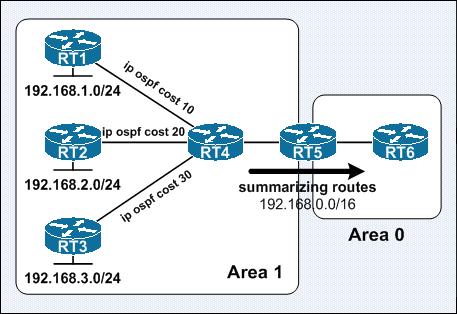RFC 1583 – OSPF Version 2 called for calculating the metric for summary routes based on the minimum metric of the component routes available.
Below shows the excerpt from Section 3.5 of RFC 1583 – OSPF Version 2:
The OSPF area concept is modelled after an IP subnetted network. OSPF areas have been loosely defined to be a collection of networks. In actuality, an OSPF area is specified to be a list of address ranges (see Section C.2 for more details). Each address range is defined as an [address,mask] pair. Many separate networks may then be contained in a single address range, just as a subnetted network is composed of many separate subnets. Area border routers then summarize the area contents (for distribution to the backbone) by advertising a single route for each address range. The cost of the route is the minimum cost to any of the networks falling in the specified range.
RFC 2178 – OSPF Version 2 (which is now obsoleted by RFC 2328 – OSPF Version 2) changed the specified method of calculating the metric for summary routes in which the component of the summary route with the maximum / largest metric would determine the metric of the summary.
Below shows the excerpt from Section 3.5 of RFC 2178 – OSPF Version 2 and Section 3.5 of RFC 2328 – OSPF Version 2:
In order to get better aggregation at area boundaries, area address
ranges can be employed (see Section C.2 for more details). Each
address range is defined as an [address,mask] pair. Many separate
networks may then be contained in a single address range, just as a
subnetted network is composed of many separate subnets. Area border
routers then summarize the area contents (for distribution to the
backbone) by advertising a single route for each address range. The
cost of the route is the maximum cost to any of the networks falling
in the specified range.
Network Setup for OSPF Route Summarization on an ABR
Below shows how all the component routes appeared in RT6’s routing table prior to implement route summarization on RT5, an OSPF ABR between area 0 and 1.
RT6#sh ip route 192.168.0.0 255.255.0.0 longer-prefixes Codes: C - connected, S - static, R - RIP, M - mobile, B - BGP D - EIGRP, EX - EIGRP external, O - OSPF, IA - OSPF inter area N1 - OSPF NSSA external type 1, N2 - OSPF NSSA external type 2 E1 - OSPF external type 1, E2 - OSPF external type 2 i - IS-IS, su - IS-IS summary, L1 - IS-IS level-1, L2 - IS-IS level-2 ia - IS-IS inter area, * - candidate default, U - per-user static route o - ODR, P - periodic downloaded static route Gateway of last resort is not set O IA 192.168.1.0/24 [110/40] via 56.56.56.5, 00:00:05, Ethernet0/0 O IA 192.168.2.0/24 [110/50] via 56.56.56.5, 00:00:05, Ethernet0/0 O IA 192.168.3.0/24 [110/60] via 56.56.56.5, 00:00:05, Ethernet0/0 RT6#
Below shows how all the summary route appeared in RT6’s routing table after implemented route summarization upon RT5. Note that RFC 1583 is in effect by default!
RT5#conf t Enter configuration commands, one per line. End with CNTL/Z. RT5(config)#router ospf 100 RT5(config-router)#area 1 range 192.168.0.0 255.255.0.0 ---------------------------------------------------------------------- RT6#sh ip route 192.168.0.0 255.255.0.0 longer-prefixes Codes: C - connected, S - static, R - RIP, M - mobile, B - BGP D - EIGRP, EX - EIGRP external, O - OSPF, IA - OSPF inter area N1 - OSPF NSSA external type 1, N2 - OSPF NSSA external type 2 E1 - OSPF external type 1, E2 - OSPF external type 2 i - IS-IS, su - IS-IS summary, L1 - IS-IS level-1, L2 - IS-IS level-2 ia - IS-IS inter area, * - candidate default, U - per-user static route o - ODR, P - periodic downloaded static route Gateway of last resort is not set O IA 192.168.0.0/16 [110/40] via 56.56.56.5, 00:00:03, Ethernet0/0 RT6#
After enabled RFC 2178 (and RFC 2328) by disabling RFC 1583 on RT5:
RT5(config-router)#no compatible rfc1583 ---------------------------------------------------------------------- RT6#sh ip route 192.168.0.0 255.255.0.0 longer-prefixes Codes: C - connected, S - static, R - RIP, M - mobile, B - BGP D - EIGRP, EX - EIGRP external, O - OSPF, IA - OSPF inter area N1 - OSPF NSSA external type 1, N2 - OSPF NSSA external type 2 E1 - OSPF external type 1, E2 - OSPF external type 2 i - IS-IS, su - IS-IS summary, L1 - IS-IS level-1, L2 - IS-IS level-2 ia - IS-IS inter area, * - candidate default, U - per-user static route o - ODR, P - periodic downloaded static route Gateway of last resort is not set O IA 192.168.0.0/16 [110/60] via 56.56.56.5, 00:00:05, Ethernet0/0 RT6#

Very helpful, thank you!
ReplyDeleteThis comment has been removed by a blog administrator.
ReplyDelete